Ant mimicry

Ant mimicry or myrmecomorphy is mimicry of ants by other organisms. Ants are abundant all over the world, and potential predators that rely on vision to identify their prey such as birds and wasps normally avoid them, because they are either unpalatable or aggressive. Some arthropods mimic ants to escape predation (protective mimicry), while others mimic ants anatomically and behaviourally to hunt ants (aggressive mimicry).[1]
To overcome ants' powerful defences, mimics may imitate ants chemically (Wasmannian mimicry) with ant-like pheromones, visually (as in Batesian mimicry, though the purpose may also be aggressive mimicry), or by copying microstructure for tactile mimicry.[2]
Batesian mimicry
.jpg)
Batesian mimics are species which typically lack strong defences of their own, and make use of their resemblance to well-defended ants to avoid being attacked by their predators, some of which may be ants.[3][4] There are ant-mimicking arthropods in several different groups, described below.
Orthoptera
Young instars of some Orthoptera, such as the katydid Macroxiphus sumatranus, have an "uncanny resemblance" to ants, extending to their black coloration, remarkably perfect antlike shape, and convincingly antlike behaviour.[3] Their long antennae are camouflaged to appear short, being black only at the base, and they are vibrated like ant antennae. Larger instars suddenly change into typical-looking katydids, and are entirely nocturnal, while the adult has bright warning coloration.[3]
Spiders
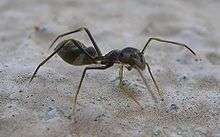
Over 300 species of spider in different families are Batesian mimics of ants,[4] such as Sphecotypus in the Clubionidae.[5] In the Salticidae family, ant-mimicking spiders can be discerned from the ants around them by the movements they make to keep the ants at an acceptable distance. Ant hunters often do not resemble ants as much.[6] Even within a closely related group, ant mimicry may have originated several times, as in the Salticidae subfamily Ballinae.[7] Mimicry has a cost: the body of spider myrmecomorphs is much narrower than non-mimics, which reduces the number of eggs per eggsac, compared to non-mimetic spiders of similar size. They seem to compensate by laying more eggsacs in their lifetime.[8] A study of three species of (predatory) mantises suggested that they innately avoided ants as prey, and that this aversion extends to ant-mimicking Salticidae.[9]
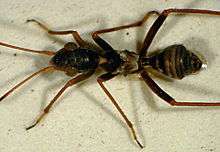
Hemiptera
Among several Hemiptera (true bugs) that resemble ants are Mirid bugs,[5] the wingless Myrmecoris gracilis which feeds on aphids,[10] while Systellonotus triguttatus, in which nymphs and females strongly resemble ants, is often found in the vicinity of ants.[11] Males of Formiscurra indicus (Caliscelidae) are antlike, but not the females.[12]
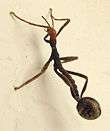
Phasmids
The phasmid Extatosoma tiaratum, while resembling dried thorny leaves as an adult, hatches from the egg as a replica of a Leptomyrmex ant, with a red head and black body. The long end is curled to make the body shape appear ant-like, and the movement is erratic, while the adults move differently, if at all. In some species the eggs resemble plant seeds, complete with a mimic elaiosome (called a "capitulum") as in plants that are associated with ants in myrmecochory. These eggs are collected by the ants and taken to their nests. The capitulum is removed and eaten and the eggs continue to be viable.[13]
Thrips
Franklinothrips is a predatory genus of thrips. Especially the females mimic ants in appearance and behavior. Ant mimicry also occurs in other genera of Aeolothripidae, where it has arisen independently, for example Aeolothrips albicinctus in Europe and A. bicolor in North America, the Australian species Desmothrips reedi, Allelothrips with seven species from Africa and India, Stomatothrips with eight species from the Americas. This kind of mimicry probably evolved as a response to the presence of ants.[14]
Mantises
While praying mantises are carnivorous insects, they also are in danger of being eaten by larger animals. The young instars of several mantids such as the bark mantid Tarachodes afzelii are Batesian mimics of ants, but there seem to be no mantids that mimic models in any other taxon. Curiously,[15] the young instars derive protection from their resemblance to ants, while bigger instars and adults, neither of which are ant mimics, eat ants.[15]
Diptera
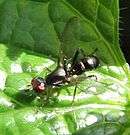
Flies that resemble ants include species in the Richardiidae genus Sepsisoma, which mimic the formicine ant Camponotus crassus.[16]
Several species of Micropezidae (stilt-legged flies) resemble ants (especially the wingless, haltere-less Badisis ambulans),[5] as do species in the genus Syringogaster, which "strikingly" resemble Pseudomyrmex and are hard even for experts to distinguish "until they take flight".[17]
Beetles
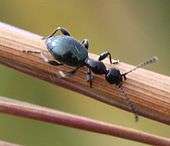
Many parasitic Staphylinidae that march with army ants strikingly resemble their hosts. An outstanding example is Ecitomorpha nevermanni, whose color varies to match the color variation of its host Eciton burchellii. Since Eciton army ants have poor vision, this is probably an example of Batesian mimicry to escape predation by vertebrates.[2]
Some genera of the Anthicidae are ant-like in appearance, for example Anthelephila cyanea. Since Anthelephila do not associate with ants, this is presumably Batesian mimicry.[18]
Members of the cerambycid genus Euderces are ant mimics. E. velutinus mimics Camponotus sericeiventris. Several other cerambycids also resemble ants. The Central American Mallocera spinicollis, Neoclytus and Diphyrama singularis all closely resemble stinging ants. Pseudomyrmecion ramalium closely resembles Crematogaster scutellaris in size and coloration and leaves in close vicinity to it. In North America certain Anthoboscus, Cyrtophorus and Tillomorpha are ant mimics. Cyrtinus pygmaeus resembles Lasius niger americanus, and Michthisoma heterodoxum mimics small workers of Camponotus pennsylvanicus.[19][20]
Aggressive mimicry

Aggressive mimics are predators which resemble ants sufficiently to be able to approach their prey successfully. Some spiders, such as the Zodariidae and Myrmarachne species including Myrmarachne melanotarsa,[4] use their disguise to hunt ants. Ant hunters often do not visually resemble ants very closely.[6]
Wasmannian mimicry
Chemical or Wasmannian mimicry enables species with ant-like pheromones to live in close contact with ants. The spider Cosmophasis bitaeniata uses chemical mimicry to be accepted by the weaver ant Oecophylla smaragdina.[21] The spider Myrmarachne assimilis is the only Myrmarachne species that resembles the aggressive weaver ant Oecophylla smaragdina, with which it lives in close contact; it likely also uses chemical resemblance.[21]
Tactile mimicry
The phoretic mite Planodiscus (Uropodidae) appears to exploit tactile or Wasmannian mimicry. The mite attaches itself to the tibia of its host ant, Eciton hamatum. The cuticular sculpturing of the mite's body as seen under the electron microscope strongly resembles the sculpturing of the ant's leg, as do the arrangements and number of the bristles (setae). The effect is presumed to be that when the ant grooms its leg, the tactile sensation is as it would be in mite-free grooming.[2]
Tactile mimicry is found in the cricket Myrmecophila acervorum; its relationship with ants was first studied by Paolo Savis in 1819. It has many ant species as hosts, and occurs in large and small morphs suited to large hosts like Formica and Myrmica, and the small workers of species such as Lasius. On first arriving in an ants' nest, the crickets are attacked by the workers, and are killed if they do not run fast enough, but within a few days they adjust their movements to match those of their hosts, and are then tolerated. Mimicry appears to be achieved by a combination of "social releasers", whether by imitating "solicitation signals" with suitable behaviour or ant pheromones with suitable chemicals; Hölldobler and Wilson (1990) propose that Wasmannian mimicry be redefined to permit any such combination.[2]
References
- ↑ Pasteur, Georges (1982). "A classificatory review of mimicry systems". Annual Review of Ecology and Systematics. pp. 169–199.
- 1 2 3 4 Hölldobler, Bert; Wilson, Edward O. (1990). The Ants. Harvard University Press. pp. 511–514. ISBN 978-0-674-04075-5.
- 1 2 3 Gwynne, Darryl T. (2001). Katydids and Bush-crickets: Reproductive Behavior and Evolution of the Tettigoniidae. Cornell University Press. p. 80. ISBN 0-8014-3655-9.
- 1 2 3 Viegas, Jennifer (15 November 2014). "More Than 300 Spiders Pretend to be Ants". Discovery.
- 1 2 3 Gullan, P. J.; Cranston, P. S. (2014). The Insects: An Outline of Entomology (5th ed.). John Wiley & Sons. p. 395. ISBN 978-1-4443-1767-1.
- 1 2 Murphy, Frances & Murphy, John (2000): "An Introduction to the Spiders of South East Asia". Malaysian Nature Society, Kuala Lumpur. Page 303
- ↑ Benjamin, S.P. (2004): A taxonomic revision and a phylogenetic hypothesis for the jumping spider subfamily Ballinae (Araneae, Salticidae). Zoological Journal of the Linnean Society 142: 1-82. Abstract + PDF
- ↑ Cushing, P. E. C. 1996. Myrmecomorphy and myrmecophily in spiders: a review. Florida Entomologist. 80(2):16-193
- ↑ Nelson, Ximena; et al. (April 2006). "Innate aversion to ants (Hymenoptera: Formicidae) and ant mimics: experimental findings from mantises (Mantodea)". Biological Journal of the Linnean Society. 88 (1): 23–32. doi:10.1111/j.1095-8312.2006.00598.x.
- ↑ E. Wachmann, A. Melber, J. Deckert: Cimicomorpha. Microphysidae (Flechtenwanzen), Miridae (Weichwanzen). Goecke & Evers, Keltern 2004. ISBN 3-931-37457-2.
- ↑ Ratcliffe, Derek A. (1977). A Nature Conservation Review: The Selection of Biological Sites of National Importance to Nature Conservation in Britain. Cambridge University Press. p. 120. ISBN 978-0-521-21403-2.
- ↑ Gnezdilov, V. M.; Viraktamath, C. A. (2011). "A new genus and new species of the tribe Caliscelini Amyot & Serville (Hemiptera, Fulgoroidea, Caliscelidae, Caliscelinae) from southern India" (PDF). Deutsch. Entomol. Zeitung. 58: 235–239. doi:10.1002/mmnd.201100026.
- ↑ Compton, S. G. and A.B. Ware. (1991) "Ants disperse the elaisosome-bearing eggs of an African stick insect". Psyche 98:207-214.
- ↑ Mound, L.A. & Reynaud, P. (2005): "Franklinothrips; a pantropical Thysanoptera genus of ant-mimicking obligate predators (Aeolothripidae)." Zootaxa 864: 1-16. PDF
- 1 2 Prete, Frederick R. (1999). The Praying Mantids. JHU Press. pp. 297–298. ISBN 978-0-8018-6174-1.
- ↑ ie, Marcio R. & Del-Claro, Kleber (2002): "Male-Male Agonistic Behavior and Ant-Mimicry in a Neotropical Richardiid (Diptera: Richardiidae)". Studies on Neotropical Fauna and Environment 37(1): 19-22. doi:10.1076/snfe.37.1.19.2114 PDF
- ↑ S.A. Marshall; M. Buck; J.H. Skevington; D. Grimaldi (2007). "A revision of the family Syringogastridae (Diptera: Diopsoidea)" (PDF). Zootaxa. Auckland, New Zealand: Magnolia Press. 1996: 1–80.
As noted by Papavero (1964), syringogastrids walking on leaves are strikingly similar to ants (especially Pseudomyrmex Lund) that often occur on the same leaf surfaces. They resemble ants in movement, size and shape (with the latter similarity enhanced by wing pigmentation), and can be difficult to distinguish from ants until they take flight.
- ↑ Kejval, Z. (2003). "The genus Anthelephila (Coleoptera: Anthicidae)". Eur. J. Entomol. 100 (3): 381–392. doi:10.14411/eje.2003.059.
- ↑ Wheeler, William Morton (1931). "The Ant Camponotus (Myrmepomis) Sereceiventris Guerin and its Mimic" (PDF). Psyche. 38 (2–3): 86–98. doi:10.1155/1931/98237.
- ↑ Monné, M. A. & F. T. Hovore. 2005. Electronic checklist of the Cerambycidae of the Western Hemisphere. Bioquip, 393 pp
- 1 2 Nelson, X.J., Jackson, R.R., Edwards, G.B. & Barrion, A.T. (2006): Living with the enemy: jumping spiders that mimic weaver ants. The Journal of Arachnology 33: 813-819. PDF (Myrmarachne assimilis)

